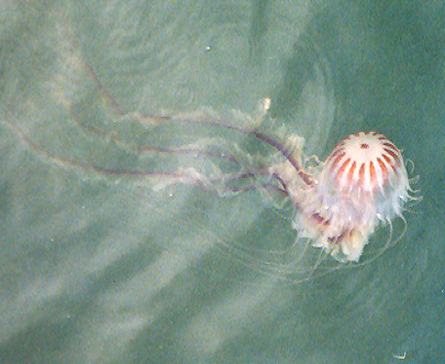Dissolved jellyfish slime turns out to be like candy for marine microbes. But the sugar high they get from feasting during a jellyfish bloom busts a leak in marine food webs that shunts valuable carbon away from fish.

Marine microbes munch on the goo that sloughs off various kinds of filmy sea animals. Booms in the jellyfish population — called blooms, which may be growing more frequent — mean an even bigger feast for bacteria. The problem is, that feast doesn’t get very far in the food web, says Rob Condon of Dauphin Island Sea Lab in Alabama.
The slime is ich in carbon, but it’s thin on nitrogen and other building blocks of life. So instead of metabolizing the bonus jelly like the everyday dissolved organic stuff microbes usually eat — “like a hamburger, maybe,” as Condon puts it — the bacteria burn through it like Red Bull. A disproportionate amount of the carbon in the dissolved mucus just gets released as carbon dioxide in respiration rather being turned into more microbe mass, Condon and his colleagues report online June 6 in the Proceedings of the National Academy of Sciences.
That carbon dioxide released into the water column “goes back to square one in the food web,” Condon says. It’s just another raw material. As far as biologists know, few fishes eat jellies directly. And as far as fish are concerned, the a jellyfish bloom is a nutritional bust.
Condon and his colleagues experimented with two jellyfish species native to the Chesapeake Bay but now blooming through much of the world: the nonstinging comb jelly Mnemiopsis leidyi and the stinging Chrysaora quinquecirrha cnidarian. Incubating them in the lab confirmed that they release substantial dissolved material. And monitoring microbial communities in laboratory samples of water where jellies had swum showed that a group called gamma-proteobacteria in particular flourished on slime.
The experiments show for the first time that dissolved material from living jellyfish can have profound effects on the way carbon cycles through marine microbes, says marine ecologist Kylie Pitt of the Gold Coast campus of Griffith University in Australia. Condon and his colleagues “have demonstrated a new type of impact of jellyfish blooms,” Pitt says.
Biologists have been discussing the possibility that jellyfish blooms are increasing worldwide, though the case is not yet proven. “A rather small set of stories about jellyfish increases are being repeated over and over again,” cautions invertebrate zoologist Claudia Mills of the University of Washington’s Friday Harbor Laboratories.






